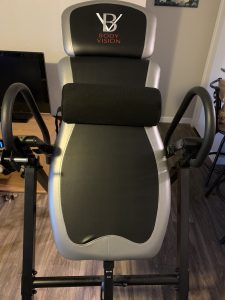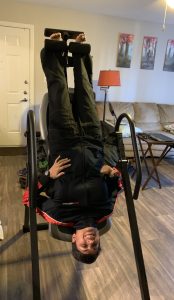To invert or not to invert, that’s the question! I bought an inversion table last year because the local sporting goods store had some pretty big sales on it and my karate instructor swears by it. What to say if a client inquires about potentially buying one?
As an exercise scientist (among other things), I didn’t want to write about inversion tables until I experienced it myself and had the chance to do some research on it.

The History of Inversion Therapy
Inversion tables are just one approach to inversion therapy. This is a type of therapy that dates back to 3000 BC! Obviously, inversion tables weren’t invented until later but there is documented history of Hippocrates, often credited as the Father of Medicine, using inversion therapy in 400 BC. It was used to stretch patients for therapeutic value and done in a rather primal way, by hanging them upside down on ladders using ropes. Inversion therapy has evolved since then!
Fast forward to the 1960’s when Dr. Robert Martin, medical doctor, osteopath, and chiropractor, did a study about “The Gravity Guidance System.” In it, he explained and showed that gravity can be used naturally to stretch and decompress the spine. Dr. Martin used gravity boots and a metal bar that could be wedged in a door frame to do this.
In the 1970s, his son, Dr. Robert Martin, Jr. published a book on inversion therapy that popularized it and found a company called Gravity Guidance and the focus was placed on gravity boots. In the 1980’s, many companies started inventing inversion tables. One of the most popular companies that still sells inversion tables today was founded by Roger Teeter. In 1981, Teeter introduced health and fitness enthusiasts to Hang Ups brand gravity boots and inversion tables. Currently, Teeter’s products are some of the most widely used and well recognized. Yet, there are several products to choose from on the market.
Using Inversion Therapy
Here’s a list of a few brands and popular models:
- Exerpeutic Inversion Table with Comfort Foam Backrest
- Health Gear Heat & Massage Therapeutic Inversion Table
- ITM 5000 Deluxe Heat and Massage Inversion Table Body Vision blank
- FitSpine X1 Inversion Table by Teeter
The question remains, are they beneficial and if so, what for?
Other questions to consider: Is purchasing one a good investment?
What if a client asks me about this? How do I answer as a fit pro?
As always, we want to stay within our scope of practice. We can educate and use our tools (such as the PAR-q) when giving feedback. If the client has medical needs and a diagnosis, it’s always best practice to refer him/her to a medical provider. While the inversion therapy has been used for centuries, I could find no hard and fast list of contraindications, but here are some conditions for which you would want to refer out:
- History of High Blood Pressure
- History of Stroke
- Fused Vertebrate
- History of Spinal Surgery
- Extreme Obesity
- Pregnant Clients
- History of Detached Retina(s)
There seem to be mixed reviews about the benefits of inversion therapy but overall, the literature states that, should it be used safely and wisely, it doesn’t tend to negatively impact users since it’s not an invasive process. It can be done at home and anecdotally, people who use it have said they feel less back pain and have more energy after inverting.
Per Dr. Shrieber (Chiropractor, Acupuncturist, and Nutritionist), this is because inverting decompresses the spine by taking the pressure off of the disks in the spine by using gravity, the very force that compresses the back all day long while we are walking, working out, driving, or doing what else we do during the day.
Inverting also helps create optimal spacing between the facet joints which allows for maximal blood flow, bringing nutrients to the spine and keeping it healthy.
The inversion process is said to relieve pressure on the nerves, release muscle tension, and help realign the spine.
Inversion therapy could help the following conditions:
• Back Pain
• Herniated discs
• Sciatica
• Degenerative disc disease
• Spinal degenerative joint disease
• Spinal stenosis
• Spinal curvature due to tight muscles
• Facet syndrome
• Muscle tension
• Muscle spasm
It is suggested using inversion therapy on active recovery days from training can help with muscle soreness and mental clarity by sending blood not just to the spine, but also the brain. Another suggested use is to invert first thing in the morning to start the day fresh and to decompress the spine before it faces a full day of gravity, especially if you are not a good sleeper or did not get a good night of sleep.
Having said that, I would take all this with a grain of salt, as there are very little quantitative and/or longitudinal research studies done on this topic.
How much does one cost: Prices vary based on its features. A basic inversion table can cost as low as $100 while one with all the bells and whistles could cost over $1000.
What to look for in an inversion table
- Safety: Make sure the frame is solid (the recommendation is steel) and not flimsy. Some prefer straps at the feet to hold the feet and ankle into the table while inverted but most tables have padded foot placement devices. Some have a pin that can help the user control the angle at which to invert (20, 40, 60, 90). Consider what the pin is made out of (it’s no different than when purchasing fitness equipment)
- Stability: This ties into safety; make sure the base is wide enough and that it is constructed in a sturdy manner. If purchasing from a box, when putting it together, take care to tighten all screws/nuts/bolts in tightly.
- Size: Based on the frame and your body size, measure it out and make sure it fits in your home.
- Comfort: In the basic models, the beds are made of plastic with very little padding. Do you want padding, heated, massage, and or lumbar support?
- Its specialized use: Why are you getting it? Some inversion therapy companies say that you can invert and do calisthenics on it. If this is the case, it may be beneficial to invest in a higher-end table so that it can handle the movement forces placed on it with firm ankle/foot straps to keep you fastened in there while you move. If you’re planning to ‘hang’ and decompress your spine on it, consider what your body would need. Some sporting goods stores will have floor models that customers can try out. If one is accessible to you, go take advantage of it! Try it out! Also, if you end up buying one, most stores and companies have a money-back guarantee or exchange policy that gives you a certain number of days to try the product out at home (like when you buy a bed).
Recommended time and duration of use:
These vary too and many recommendations are largely anecdotal from patients’ and clients’ perspectives or feedback from doctors and practitioners who recommend this treatment in their practice.
*The general consensus is that if you are new to inversion, start slow and at a 20% inversion and for only 1-2 minutes.
For progression: After a few weeks, try going to 40% for 1-2 minutes. Then move to 60% until working your way up to the full 90%.*
There are some branded tables that state you can stay in it for up to 90 minutes and do an entire workout routine, providing video instructions to do so.
My Experience
I bought mine last year; until a couple of weeks ago, I have only been inverting to 20%. I have a Body Vision Inversion Table with  Head Pillow ITM9825G. It’s padded and does the trick. But then again, I’m not trying to do an ab work out on it, and I’m not necessarily promoting the one I have. Just saying it works for me!
Head Pillow ITM9825G. It’s padded and does the trick. But then again, I’m not trying to do an ab work out on it, and I’m not necessarily promoting the one I have. Just saying it works for me!
After reading more about inversion tables and the general recommendations, I’ve worked my way to inverting at 40% then to 60%. The difference is pretty palatable! I use it first thing in the morning to get my day started. I’m super sensitive to caffeine and am not a coffee drinker, so I was looking for an alternative to “waking up”.
Also, I’m on my feet and running around working with clients and teaching all day, and then I come home and play with my cat. OR, I’m sitting and doing research and writing blogs, hunched over my computer, despite my best efforts to maintain good posture! I’ve found inverting daily helps me with my back pain and as stated, decompresses my spine. But I don’t use it to replace a professional check-up and treatment when needed.
References:
https://en.wikipedia.org/wiki/Inversion_therapy
https://reviews.chicagotribune.com/reviews/best-inversion-tables
Shaweta “Shay” Vasudeva, MA (Psychology), MS (Kinesiology), NFPT-CPT, NASM-CPT-CES, THSA-CNT, and Tai Chi & Black Belt Karate Instructor is a teaching professional, speaker, author, coach, and cat lover! Her passion is to help people become the best version of themselves by using an interdisciplinary and holistic approach, bringing 10+ years of experience in Psychology, Personal Fitness Training, Corrective Exercise, Nutritional Coaching, Cranial Sacral Work, and teaching Karate & Tai Chi classes to her business, ShayTheCoach. Shay teaches classes at Maricopa Community College District as an Adjunct Professor. For more information visit her personal webpage: www.shaythecoach.com


